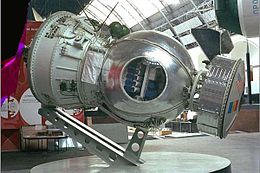Bion-M

A Bion spacecraft, on display
|
|
| Manufacturer | TsSKB Progress |
|---|---|
| Country of origin |
Soviet Union Russia |
| Applications | Bioscience |
| Specifications | |
| Design life | 5-22 days |
| Regime | Low Earth orbit |
| Production | |
| Status | Retired (Bion-M in service) |
| Launched | 11 |
| First launch |
Kosmos 605 31 October 1973 |
| Last launch |
Bion No.11 24 December 1996 |
| Related spacecraft | |
| Derived from |
Vostok Voskhod Zenit |
| Derivatives | Bion-M |
 An artist's concept of a Bion satellite in orbit |
|
The Bion satellites (Russian: Бион), also named Biocosmos, were a series of Soviet (later Russian) biosatellites. They were part of the Kosmos satellites.
The Soviet biosatellite program began in 1966 with Kosmos 110, and resumed in 1973 with Kosmos 605. Cooperation in space ventures between the Soviet Union and the United States was initiated in 1971, with the signing of the United States and Soviet Union in Science and Applications Agreement (which included an agreement on space research cooperation). The Soviet Union first offered to fly US experiments on a Kosmos biosatellite in 1974, only a few years after the termination (in 1969) of the U.S. biosatellite program. The offer was realized in 1975 when the first joint U.S./Soviet research were carried out on the Kosmos 782 mission.
The Bion spacecraft were based on the Zenit (satellite) and launches began in 1973 with primary emphasis on the problems of radiation effects on human beings. Launches in the program included Kosmos 110, 605, 690, 782, plus Nauka modules flown on Zenit-2M reconnaissance satellites. 90 kg of equipment could be contained in the external Nauka module.
The Soviet/Russian Bion program provided U.S. investigators a platform for launching Fundamental Space Biology and biomedical experiments into space. The Bion program, which began in 1966, included a series of missions that flew biological experiments using primates, rodents, insects, cells, and plants on a biosatellite in near-earth orbit. NASA became involved in the program in 1975 and participated in 9 of the 11 Bion missions. NASA ended its participation in the program with the Bion 11 mission launched in December 1996. The collaboration resulted in the flight of more than 100 U.S. experiments, one-half of all U.S. Life Sciences flight experiments accomplished with non-human subjects.
...
Wikipedia
